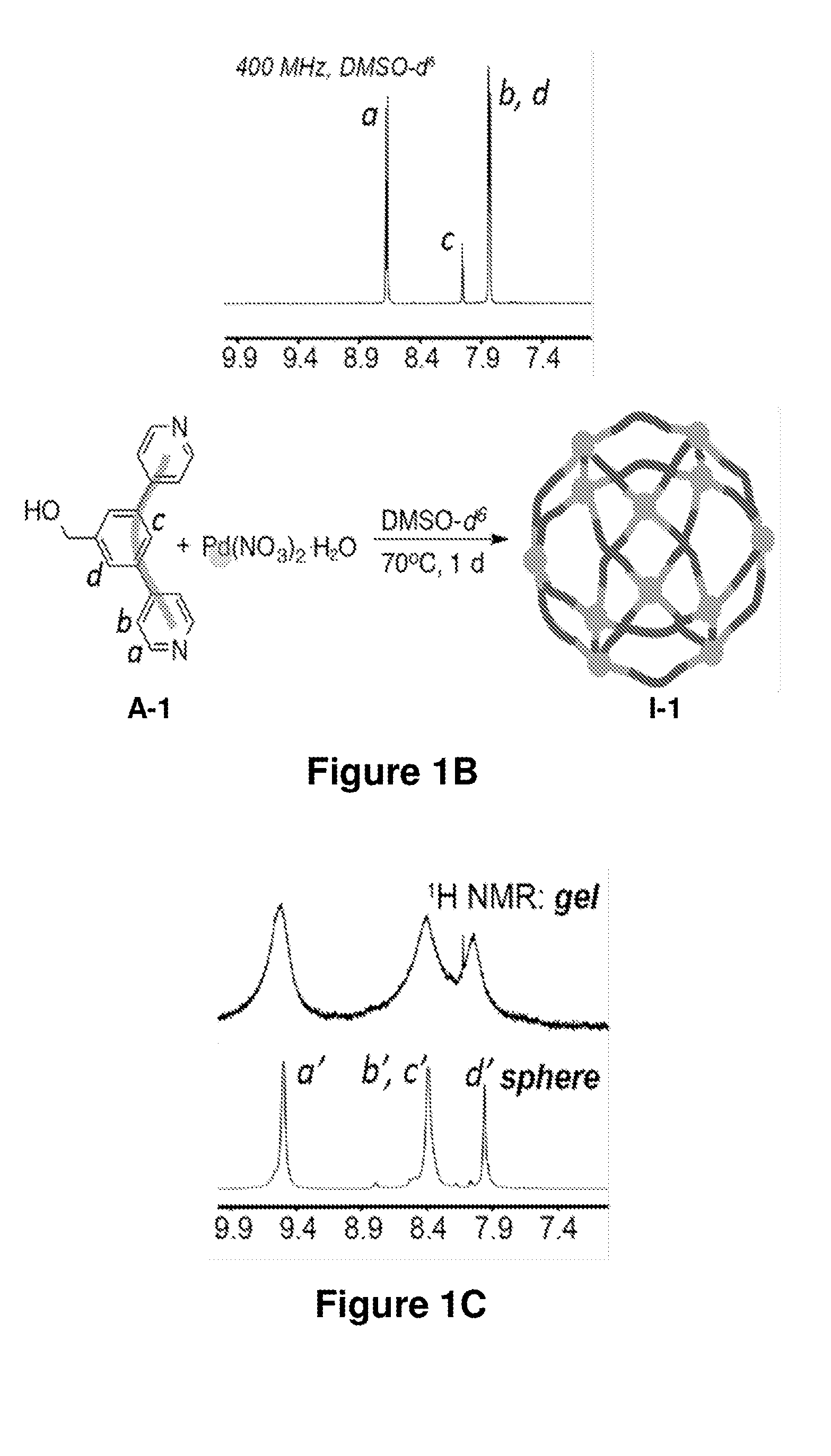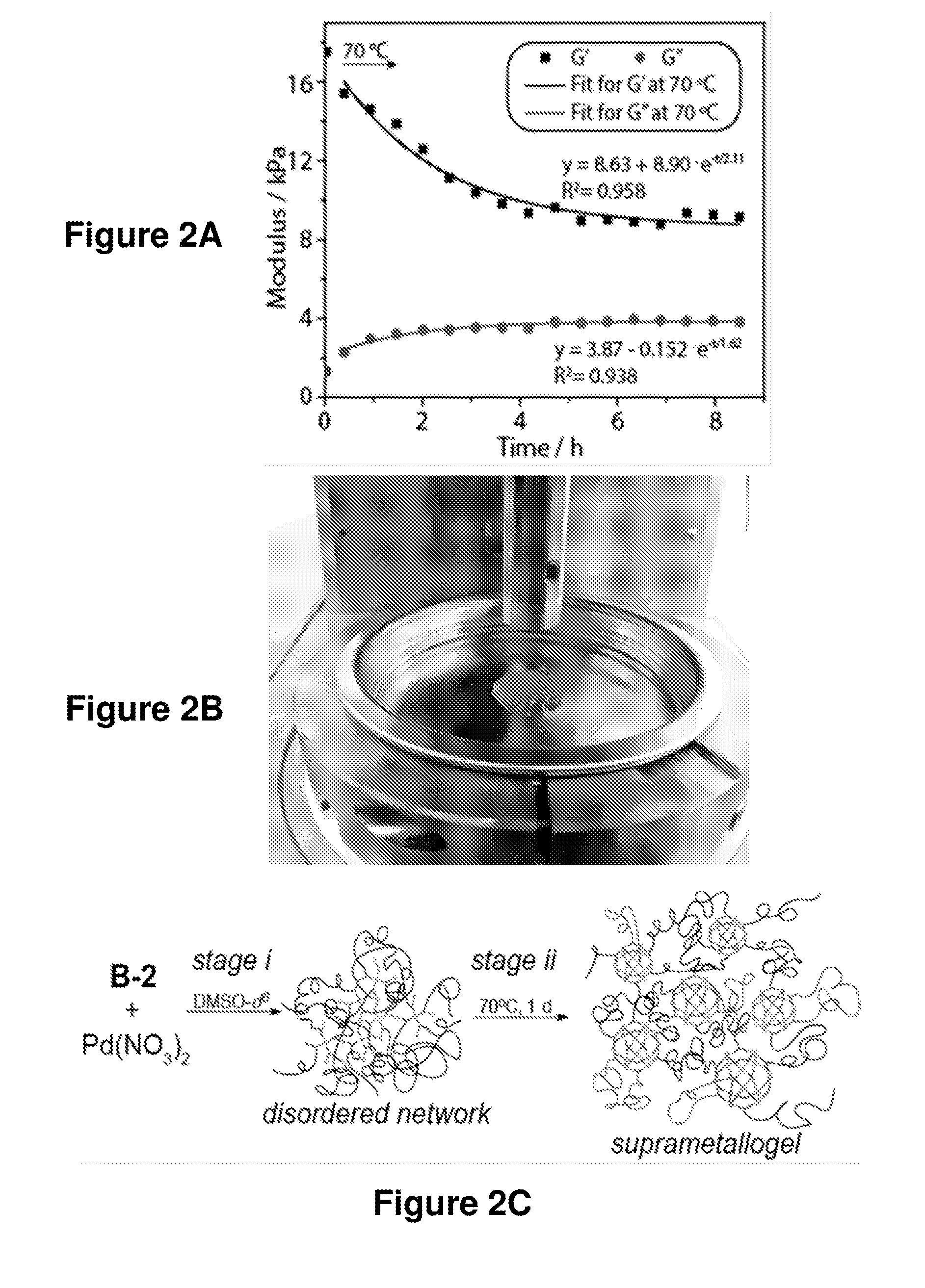Suprametallogels and uses thereof
a technology of suprametallogels and gels, applied in the field of suprametallogels, can solve the problems of inability to shear-thin or heal the gel formed entirely from the former, and is generally subject to viscous flow, and achieves the effect of high storage moduli and new material properties
- Summary
- Abstract
- Description
- Claims
- Application Information
AI Technical Summary
Benefits of technology
Problems solved by technology
Method used
Image
Examples
example 1
Preparation and Characterization of Ligand B-1
[0438]In an exemplary set of experiments, diacids
such as
were synthesized according to the method shown in Scheme 5 (see, e.g., U.S. Pat. No. 8,067,505), wherein the number-average molecular weight (Mn) of the PEG moiety
was about 2 kDa, 4.6 kDa, 6 kDa, 10 kDa, 25 kDa, and 35 kDa. The yields were at least about 80%.
[0439]In an exemplary set of experiments, diacid
was synthesized according to the method shown in Scheme 6 in a 92.4% yield, and the product was pure by 1H NMR and mass spectroscopy (MALDI-TOF).
[0440]In an exemplary set of experiments, telechelic bromo-poly(n-butyl acrylate) (telechelic bromo-pNBA) with a Mn of 4.2 kDa (degree of polymerization (DP) was about 30; and polydispersity (PDI) was about 1.13 as determined by GPC) or 13.9 kDa (DP was about 106); and PDI was about 1.08 as determined by GPC).
[0441]In an exemplary set of experiments, ligand B-1 was prepared according to the method shown in Scheme 7. An exemplary 1H NMR spe...
example 2
Preparation and Characterization of Nanosphere I-1
[0442]In an exemplary set of experiments, nanosphere I-1 was prepared according to the method in Scheme 3, steps (b-1) and (b-2), wherein the ligand of Formula (A) was ligand A-1, and the Pd(II) salt was Pd(NO3)2. To a 2-mL vial with A-1 (13.13 mg, 0.05006 mmol) dissolved in 366.7 μL of DMSO-d6 was added via micropipette a solution of Pd(NO3)2.2H2O (6.67 mg, 0.02503 mmol) in 133.3 μL of DMSO-d6. The head-space of the vial was briefly purged with argon, the vial was closed with a screw-cap, and the resultant mixture was immediately vortexed, giving rise to a light-yellow liquid with small gelatinous pieces dispersed in it. The mixture was heated at 70° C. for 8 h, during the course of which, it became a light yellow homogeneous solution. A liquid was formed, which contained predominantly one supramolecular species. An exemplary 1H NMR spectrum (DMSO-d6) of the resulting nanosphere I-1 evidenced the formation of nanospheres. Exemplary ...
example 3
Preparation and Characterization of Supramolecular Complexes and Gels
[0443]In another exemplary set of experiments, supramolecular complexes and gels were prepared according to the method of FIG. 1A. The formation of the supramolecular complexes and gels were evidenced by 1H NMR (FIG. 1C). Gelation was virtually instantaneous at the sites where the reactants came into contact. After the reaction mixture was heated at 70° C. for 8 hours or 80° C. for 4 hours, it became homogeneous. When ligand B-2 and Pd(NO3)2 were combined at a concentration of 0.01 M with a 15% excess of ligand B-2, the reaction mixture became a homogeneous liquid after heating at 100° C. overnight; the 1H NMR spectrum of the resulting mixture suggested formation of nanospheres. The rate of gelation can be tuned by adjusting the reactivity of the transition metal (e.g., Pd(II)) salt. In some cases, the more labile the counterion of the transition metal salt, the more rapid the gelation is. Pd(NO3)2 and [(MeCN)4Pd2+...
PUM
| Property | Measurement | Unit |
|---|---|---|
| Nanoscale particle size | aaaaa | aaaaa |
| Nanoscale particle size | aaaaa | aaaaa |
Abstract
Description
Claims
Application Information
 Login to View More
Login to View More - R&D
- Intellectual Property
- Life Sciences
- Materials
- Tech Scout
- Unparalleled Data Quality
- Higher Quality Content
- 60% Fewer Hallucinations
Browse by: Latest US Patents, China's latest patents, Technical Efficacy Thesaurus, Application Domain, Technology Topic, Popular Technical Reports.
© 2025 PatSnap. All rights reserved.Legal|Privacy policy|Modern Slavery Act Transparency Statement|Sitemap|About US| Contact US: help@patsnap.com



